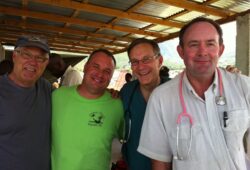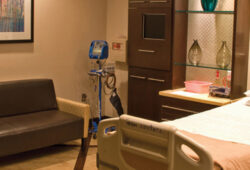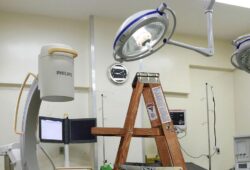Hospital Sisters Mission Outreach collects unused medical supplies and equipment from U.S. hospitals for provider organizations in the developing world.
In June, Andean Health and Development celebrated the opening of its newest project, the Hesburgh Hospital located in Santo Domingo, Ecuador. Several years and millions of dollars in the making, the 60-bed hospital is providing both basic and more advanced medical services to a region of the world that is lacking in quality accessible healthcare. Patients are receiving much-needed care with beds and lights donated by Hospital Sisters Mission Outreach, one of 15 medical surplus recovery organizations (MSROs) in the United States that receives surplus medical supplies and equipment from hospitals, clinics and manufacturers and redistributes them to healthcare provider organizations in developing countries.
Georgia Winson, executive director of Mission Outreach, says working with an MSRO provides a great benefit to hospitals: “In addition to helping save lives around the world, it saves them money on waste disposal costs, frees up storage space and can count toward their community benefit requirements.”
Mission Outreach, a ministry of the Hospital Sisters of St. Francis, provided about 85 percent of the startup medical supplies and equipment for Hesburgh Hospital, representing just a small portion of the $6 million in usable medical equipment and supplies the Springfield, Illinois-based MSRO distributes worldwide each year. Since its founding in 2002, it has distributed more than $40 million in high-quality supplies and equipment to over 200 hospitals and clinics in 75 countries, including many in Africa and Central and South America, as well as Haiti, Pakistan, Syria and Ukraine.
At any given time, Mission Outreach’s two warehouses, totaling 43,000 square feet of storage space, are stocked with $6 million worth of inventory, ranging from high-demand basics like gloves, gauze, sutures, incubators, blood pressure monitors and oxygen concentrators to OR lighting, hospital beds, orthopedic rehabilitation equipment and more. Earlier this year, Mission Outreach sent a mobile medical clinic to Guatemala. In 2010, the organization, with the help of the U.S. Navy, delivered an ambulance to the city of Las Parejas in Buenos Aires, Argentina.
Mission Outreach currently partners with 61 hospitals and clinics in Illinois, Wisconsin, Indiana and Missouri—all within about a 300-mile radius of the Springfield, Illinois, warehouse. According to Winson, that’s about as much territory as the program’s three semi-truck drivers can cover.
Mission Outreach employees work hard to coordinate with hospital partners to make sure each truck is full before returning to the warehouse. She says her team already does a good job of accurately predicting and planning for each donation, but they’re working to improve the process to benefit other areas of the program.
“We have begun talking to the supply directors and asking them to look toward the future when they’re making equipment changes,” she says. “That way, if we know of a need in the developing world, we can let them know when that equipment will be available.”
Mission Outreach will soon deliver supplies and equipment, made possible through a long-term partnership with Rotary International District 6450 and the Archdiocese of Chicago, to a new hospital in Nigeria. Among the donations will be lights with the electrical components still attached.
“One of our partners here let us know it was planning to switch out lights, so we provided instructions on how to de-install the old ones so they could be useful to the hospital in Nigeria,” Winson says.
Each recipient organization goes through a thorough application process, which helps ensure the good use of supplies and equipment once they’re received.
“We do reference checks and find out important information like their electrical current and the weight-bearing limit of their floors, and whether they have access to water or technicians to service specific pieces of equipment,” Winson says. “That assessment is part of why Mission Outreach works so well.”
Once donations arrive at the Mission Outreach warehouse, volunteers begin the tedious work of sorting by category, expiration date and then by specific item. Last year, it took 27,000 volunteer hours to do the sorting. Winson says Mission Outreach does receive expired goods as donations, and while they can’t be used for treating humans, they can be donated to animal shelters, nursing schools and even daycare centers for alternate uses.
“We do everything we can to be as green as possible, ” she says.
Once donations are sorted, they’re logged into an inventory management system that connects to partners in the developing world. U.S. mission workers can use it to view available inventory and place orders, which are packaged in 40-foot, 20-foot or smaller containers that a mission worker can carry into the country.
Securing funding to send the supplies is a high priority. The average value of the supplies and equipment that can fit in a 40-foot shipping container is $120,000, and it costs Mission Outreach about $23,400 to put a single container together.
Recipients are responsible for raising $6,200 plus the cost of shipping, which can range from $4,000 to $7,000, depending on the destination. Many partners in the developing world work with nonprofit or corporate sponsors to help raise these funds, and Mission Outreach’s U.S.-based partners are asked to make monetary donations as well.
Winson says there’s no shortage of need in the developing world, but there’s only so much Mission Outreach can do. That’s why the organization helped found the MedSurplus Alliance (medsurplusalliance.org) to promote the use of MSROs by hospitals, clinics, manufacturers and distributors and increase the quantity and quality of MSROs around the country.
For more information, visit www.mission-outreach.org.
Share Email Missions, Social Stewardship





